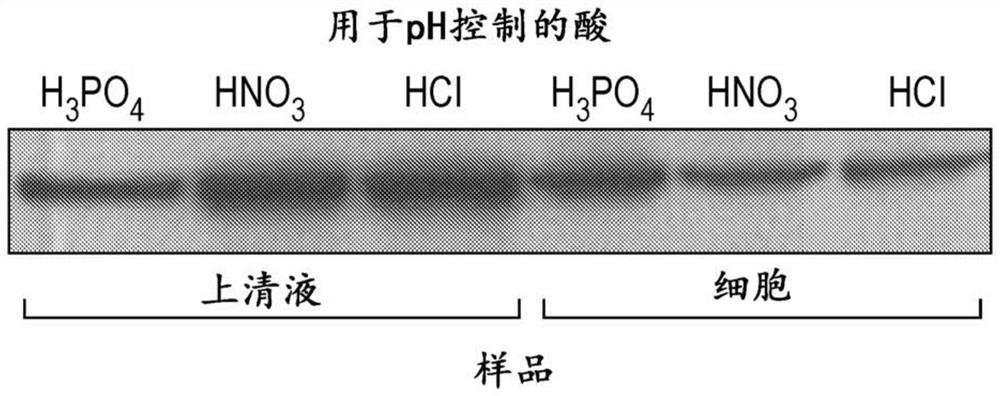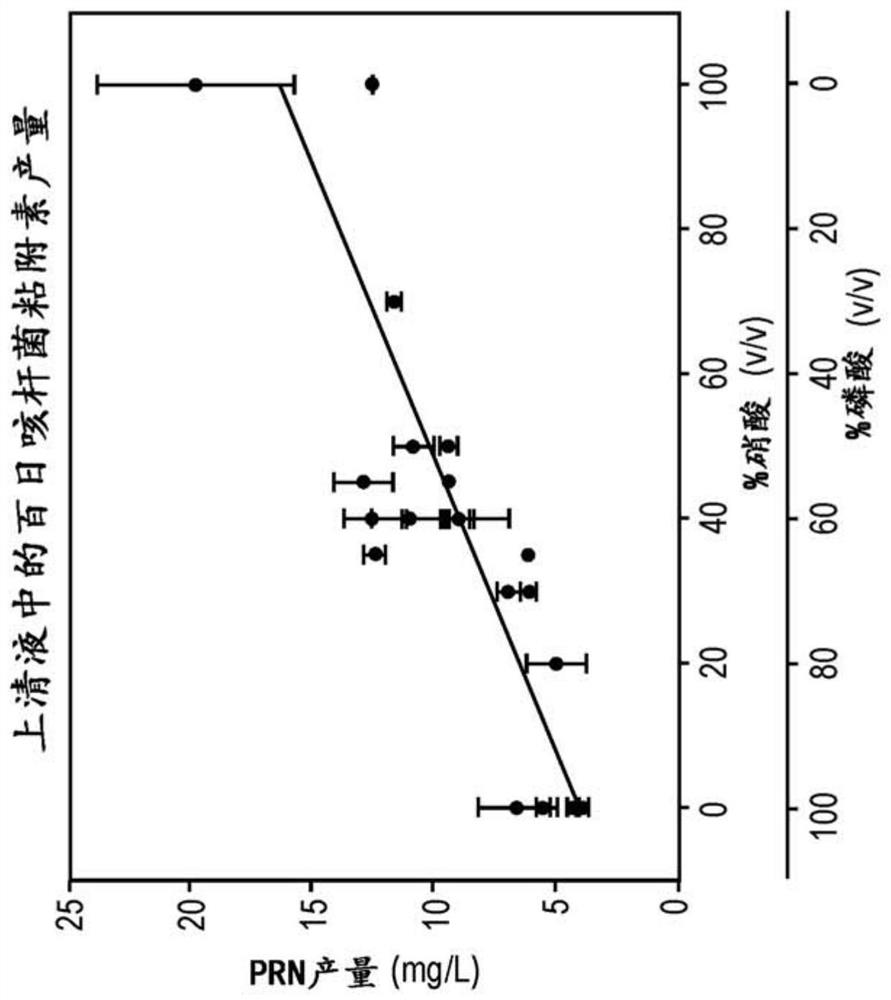Methods of cultivating bordetella species
A technology of Bordetella and Tertella, applied in biochemical equipment and methods, bacteria, antibacterial drugs, etc., can solve problems such as antigen loss
- Summary
- Abstract
- Description
- Claims
- Application Information
AI Technical Summary
Problems solved by technology
Method used
Image
Examples
Embodiment 1
[0102] Example 1. Strong acids increase PRN production in supernatants from Bordetella cultures.
[0103] Working seeds (2.5 mL) were inoculated in 2L shake flasks each containing 500 mL of broth (modified Stainer-Scholte medium, Table 3) with 5 mL of 100x growth factor solution (Table 4). The culture was grown in an incubator shaker for 44 hours and used to inoculate a 2L fermentor / bioreactor (2L BIOSTAT B fermenter (B. Braun Biotech International, Berlin, Germany)) containing 1150 mL of a solution supplemented with growth factors ( Table 4) broth (modified Stainer-Scholte medium, Table 3).
[0104] Feed supplements of monosodium glutamate and growth factors, glutathione, ferrous sulfate, ascorbic acid, niacin, and cysteine are continuously added to the bioreactor during the incubation period to increase antigen production . The addition of supplemental solution was triggered by a sharp increase in dissolved oxygen (DO) levels and a sharp decrease in agitation, which occu...
Embodiment 2
[0115] Example 2. Acid mixtures increase PRN and FIM2 / 3 production in supernatants from Bordetella cultures while mitigating PT and FHA loss.
[0116] Cultures were prepared as described above for Example 1, except that different ratios of mixtures of nitric acid and phosphoric acid were used for bioreactor pH control. PRN, PT, FHA, and FIM2 / 3 antigens were isolated to assess the effect of the acid mixture on antigen production. At the end of the incubation period, the harvest was centrifuged to obtain a cell fraction and a supernatant fraction. Supernatant fractions were assayed for PRN, PT, FHA and FIM2 / 3 antigens by ELISA. Cell pellets were resuspended in water for injection (WFI) and treated with 8M urea to lyse cells and release FIM2 / 3 for analysis by ELISA.
[0117] Figures 2A-2D The production of each antigen in the bioreactor harvest as measured by ELISA is shown for multiple bioreactor runs. Figure 2A It was confirmed that PRN production in the bioreactor harves...
Embodiment 3
[0120] Example 3. Acid mixtures and chemically defined media further enhanced PRN and FIM2 / 3 production in supernatants from Bordetella cultures while mitigating PT and FHA loss.
[0121] Cultures were also prepared as described above for Example 1, except chemically defined medium was used instead of complex medium. As described in Example 2, a mixture of nitric acid and phosphoric acid at different ratios was used for bioreactor pH control. PRN, PT, FHA and FIM2 / 3 antigens were isolated as described above for Example 2.
[0122] Figure 3 shows the production of each antigen in the bioreactor harvest, as measured by ELISA, for multiple bioreactor runs. Figure 3A -D also confirmed that when 100% 3.5M nitric acid was used instead of 100% 2.5M phosphoric acid for pH control, the yield of PRN in the bioreactor harvest supernatant fraction increased (5-7mg / L to 14-22mg / L L). Additionally, Figure 3 also confirms that when a solution containing 100% 3.5M nitric acid was used inste...
PUM
 Login to View More
Login to View More Abstract
Description
Claims
Application Information
 Login to View More
Login to View More - R&D
- Intellectual Property
- Life Sciences
- Materials
- Tech Scout
- Unparalleled Data Quality
- Higher Quality Content
- 60% Fewer Hallucinations
Browse by: Latest US Patents, China's latest patents, Technical Efficacy Thesaurus, Application Domain, Technology Topic, Popular Technical Reports.
© 2025 PatSnap. All rights reserved.Legal|Privacy policy|Modern Slavery Act Transparency Statement|Sitemap|About US| Contact US: help@patsnap.com



